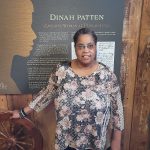Continuing the search for lost voices in Delaware history
The search continues for lost voices in Delaware history as part of the Plantation Stories Project at the John Dickinson Plantation, as well as the Segregated Sands exhibit from the Zwaanendael Museum. Together they aim to chronicle the lives of hundreds of African American people who were oppressed and marginalized throughout First State history.
“Recognizing Delaware’s complicated history is essential,” said Division of Historical and Cultural Affairs Deputy Director Suzanne Savery. “The research undertaken by the Division staff to document and share the voices of those who have been ignored is critical. Through their work, those visiting the museums or exploring online can learn the difficult and complex history of both our state and our nation.”
The Plantation Stories Project will reach a national stage in June when staff members with the Division of Historical and Cultural Affairs share the project’s progress at the national Association for Living History, Farms and Agricultural Museums’ (ALHFAM) annual conference in Tacoma, Washington. The conference, titled “The Future of the Past,” will focus specifically on diversity and provide an opportunity to showcase the important work being done in Delaware at a national level.

The Project’s mission is to find and share the stories of the hundreds of people who lived, labored and died at the John Dickinson Plantation, particularly people of color. It builds on the decades of research completed at the historical site. A new user-friendly digital platform for the project is in the works through a partnership with the state’s Government Information Center.
A major research challenge is that the documents informing this project primarily come from white colonizer enslavers’ perspectives, which will never be objective nor complete. Some information may never be found.
The site is currently integrating the recent discovery of the African Burial Ground, the construction of pathways and the work of the Plantation Stories Project, which is a searchable online database with the names and information of free and enslaved African Americans associated with the Plantation.



This impactful work has also earned well-deserved recognition within the First State. The main team behind the project — Annie Fenimore, Gloria Henry and Vertie Lee — not only earned the title of Department of the State employees of the year for 2021, along with their colleague Sakinaa Rock, but also recently earned the team the Delaware Award for Excellence and Commitment in State Service awarded by Gov. John Carney.
“Our commitment to this project is for neither accolades nor awards because it’s truly not about us,” said Fenimore, lead interpreter at the Plantation. “The Plantation Stories Project is about all those whose memory has not been actively preserved. I’m motivated to be able to share with the public our discoveries about the people whose lives we are trying to recover through research. It’s thrilling to be at the start of a project that works to broaden the scope of local history, make our site’s interpretation more inclusive, and share formerly marginalized individuals’ stories.”
Meanwhile, the team behind the digital presentation of Segregated Sands earned recognition as the Department of State’s employees of the first quarter in 2022. Those employees are the Division’s Bridget Warner, Katilyn Dykes, and former University of Delaware intern Kelli Barnes, as well as Government Information Center staff members Amber Weeks and Kathy Szczesny.Segregated Sands is a virtual exhibit that aims to broaden an understanding of Delaware’s beaches throughout history, in a format that’s easy for the public to view. During the Jim Crow Era, from about the late 1800s to the 1960s, segregation ruled Delaware’s beaches, as it did most public spaces in states normally associated with the U.S. South. The Division’s ongoing oral history project, Recapturing Black Beaches, will ultimately enhance and broaden the Segregated Sands exhibit. These stories shed light on Delaware’s segregated beaches during Jim Crow. To view this exhibit, go to history.delaware.gov/zwaanendael-museum/segregated-sands.


